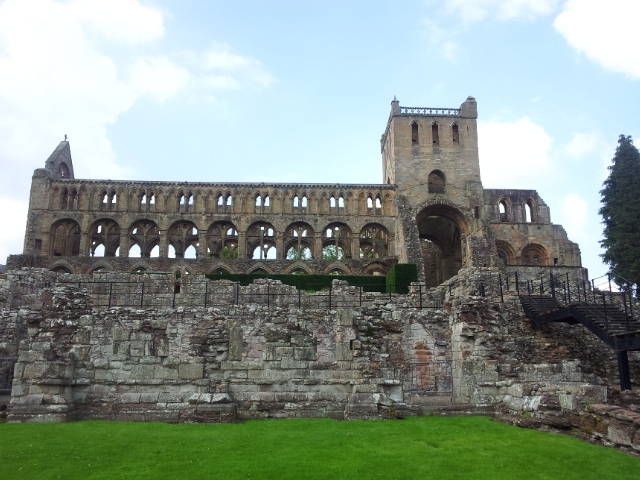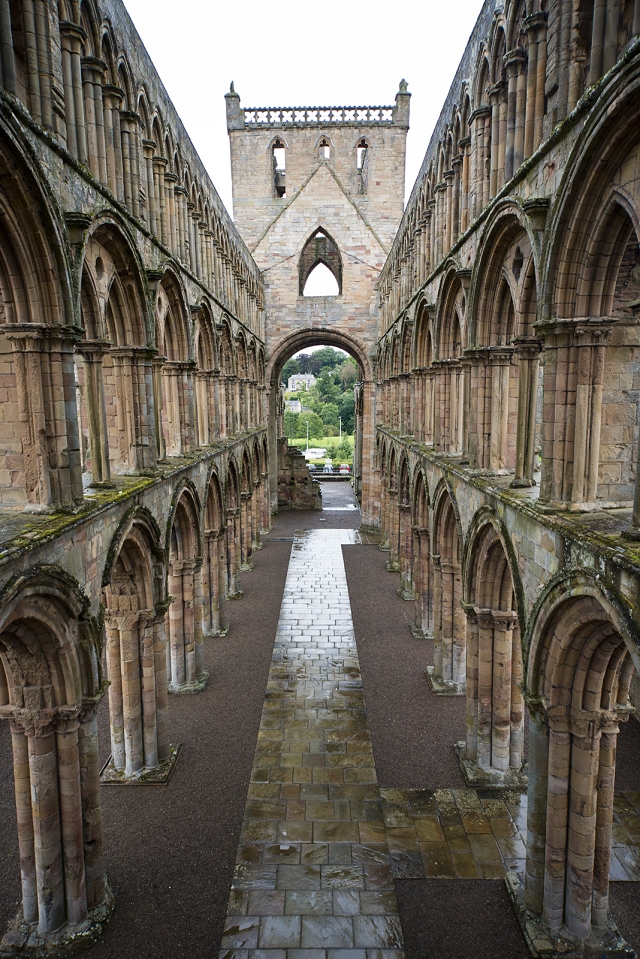
The tranquil spot brazenly chosen by King David in 1138 to prove he was not intimidated by the English presence just across the border proved to be a trial for the community of Augustinian canons who resided here.
The southernmost of the border abbeys, Jedburgh was the first target for every English army crossing this part of the Borders. The remains of the church are all that survive, due to the continued use by the parishioners between the period of the Reformation in 1560 to 1875.
The abbey is situated in the town of Jedburgh, atop a very steep hill. Showing passes and taking a cursory look around the gift shop we set out to explore the ruins which are dominated by the imposing edifice of the nave.
We climb the stairs past the low walls and rubble that make up the refectory, dormitories, cellars and cloister, in the center of which lay the canons' garden.
A lovely garden has been planted in this area now, filled with herbs and ornamental flowers many of which are bloom. Passing through an intricately carved doorway, which is embellished with Biblical figures, flora and fauna, we enter the nave with its stout pillars and many windows. Up a spiral staircase, which is so steep a rope has been provided to aid visitors in hoisting themselves upward, we reach a landing that looks out on the town and across to the west front of the church with its striking rose window.
An exhibit on the upper level of the Visitors' Centre holds carvings that have fallen from the building over the years and artifacts – some of which were found on the remains of a body discovered during excavation near the chapter house in 1984. Examination and investigation of the remains led scholars to tentatively identify the body as that of Eadwulf Rus, grandson of Earl Uchtred of Northumbria, and one of the assassins of Bishop Walcher of Durham. He, himself, was later murdered.
Buried in the church at "Geddewerde" (Jedburgh), his body was later exhumed and thrown out of the church by Turgot, Archdeacon of Durham. An exquisite ivory comb, dated to 1100, and other objects consistent with belonging to the grandson of an earl, were found with the body supporting this theory. All are on display in glass cases. Additional evidence is the belief that as early as 830 there was an Anglo-Saxon church located here, founded by Bishop Eegred of Lindisfarne. An impressive carved shrine bearing vines, birds and beasts and dated to the 8th century was found here and is on display as well.
My book buying spree continues in the gift shop where I pick up the last copy of a Scots herbal. This comprehensive directory of indigenous herbs not only lists the names in Latin, it also lists Scots name, local name, Gaelic name and includes entries on medicine, folklore, textiles and cooking for each plant. This is more than I could have ever hoped for and I'm so happy to mentally tick off the last item on my list of books I was seeking. That doesn't stop me from purchasing another though; I also pick up a book on Celtic Saints.
A quick lunch stop at a cafe at the bottom of the hill where I enjoy a prawn mayonnaise on brown bread sandwich, and then we're back to the car, heading northwest this time, toward Dryburgh.

As well as the lands and chapels in southern Scotland, Jedburgh Abbey owned great lands in Northumberland. In 1296, the Abbot of Jedburgh swore fealty to Edward I of England at Berwick-on-Tweed. Edward intended to rule the abbey and presented William de Jarum as the new Abbot of Jedburgh in 1296.
After the defeat of the Earl of Surrey in 1297 at Stirling at the hands of William Wallace, the abbey was pillaged and wrecked by the English as retribution. Robert I of Scotland (The Bruce) continued to patronize the church during his reign in the early 14th century.
In 1346, after the Scottish defeat at the Battle of Neville's Cross, the English once again slighted the church. Later that century, in 1370, David II of Scotland was instrumental in the completion of the north transept we can still see today.
The abbey faced more torture and destruction in 1410,1416 and by the Earl of Warwick in 1464. In 1523, the town and abbey were set ablaze by the Earl of Surrey. The abbey faced more indignity in 1544 at the hands of the Earl of Hertford.
The end came for the great Abbey of St. Mary of Jedburgh in 1560 and the coming of the Scottish Reformation.
Read more about Jedburgh Abbey at Wikipedia